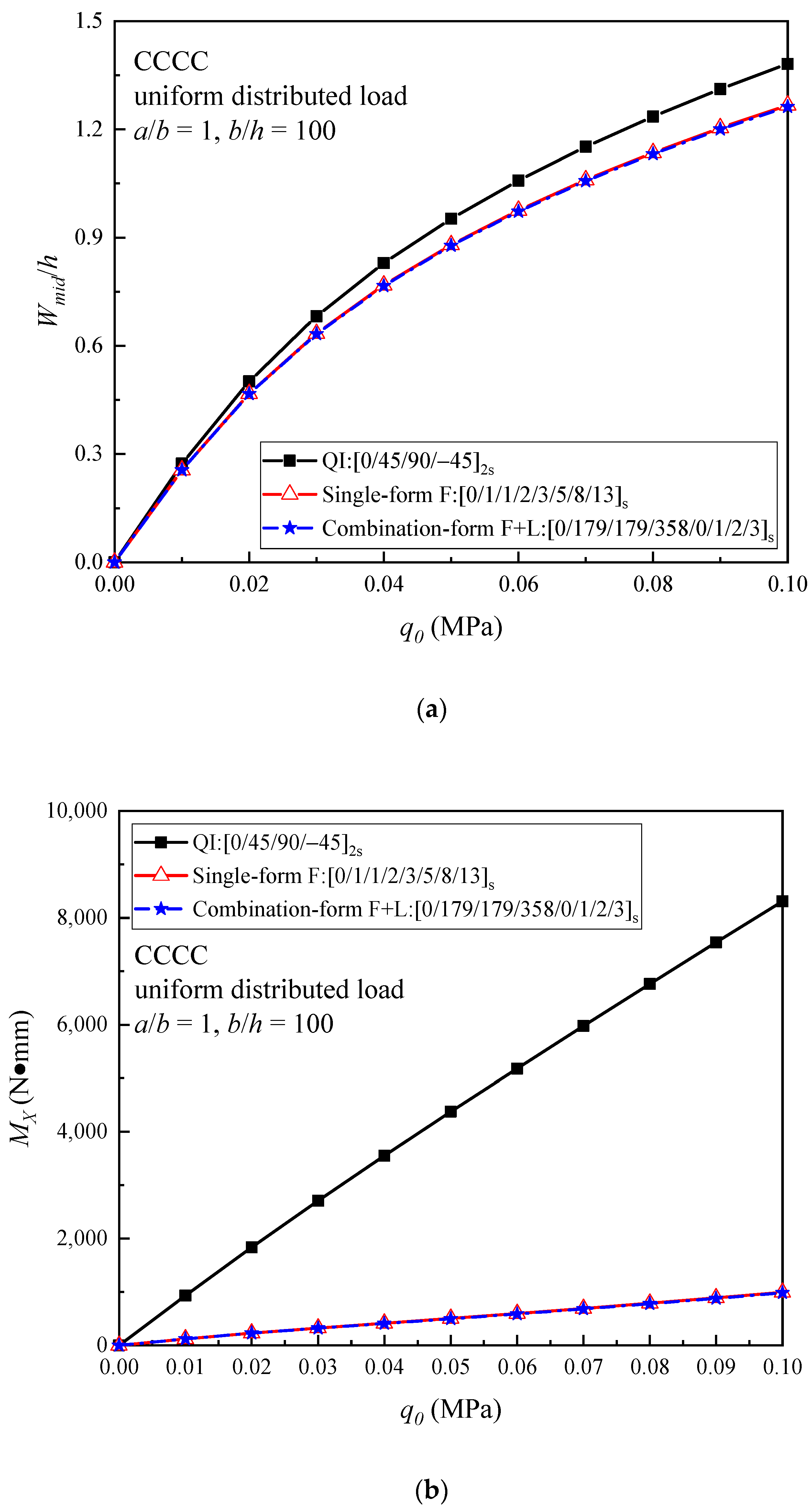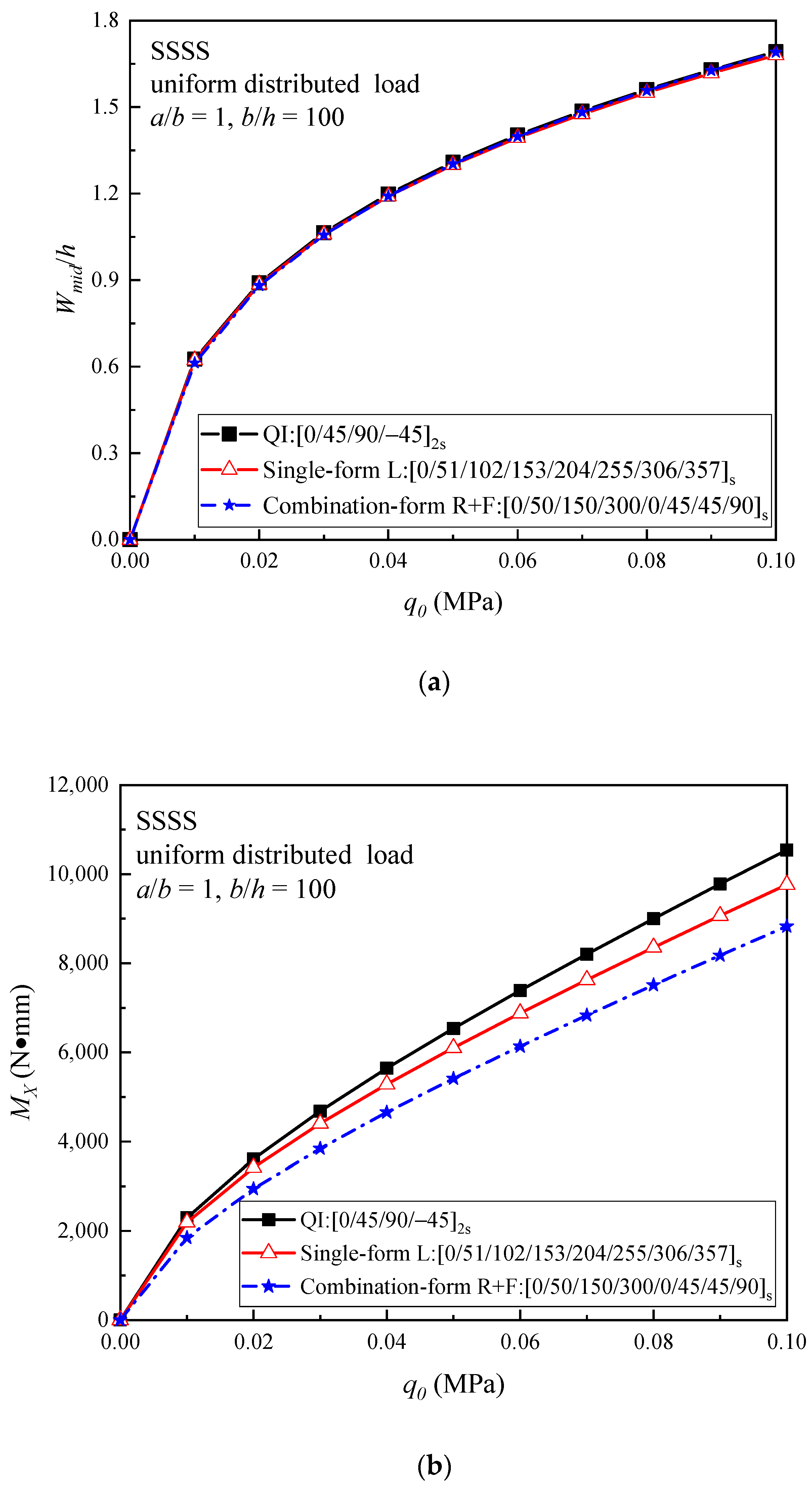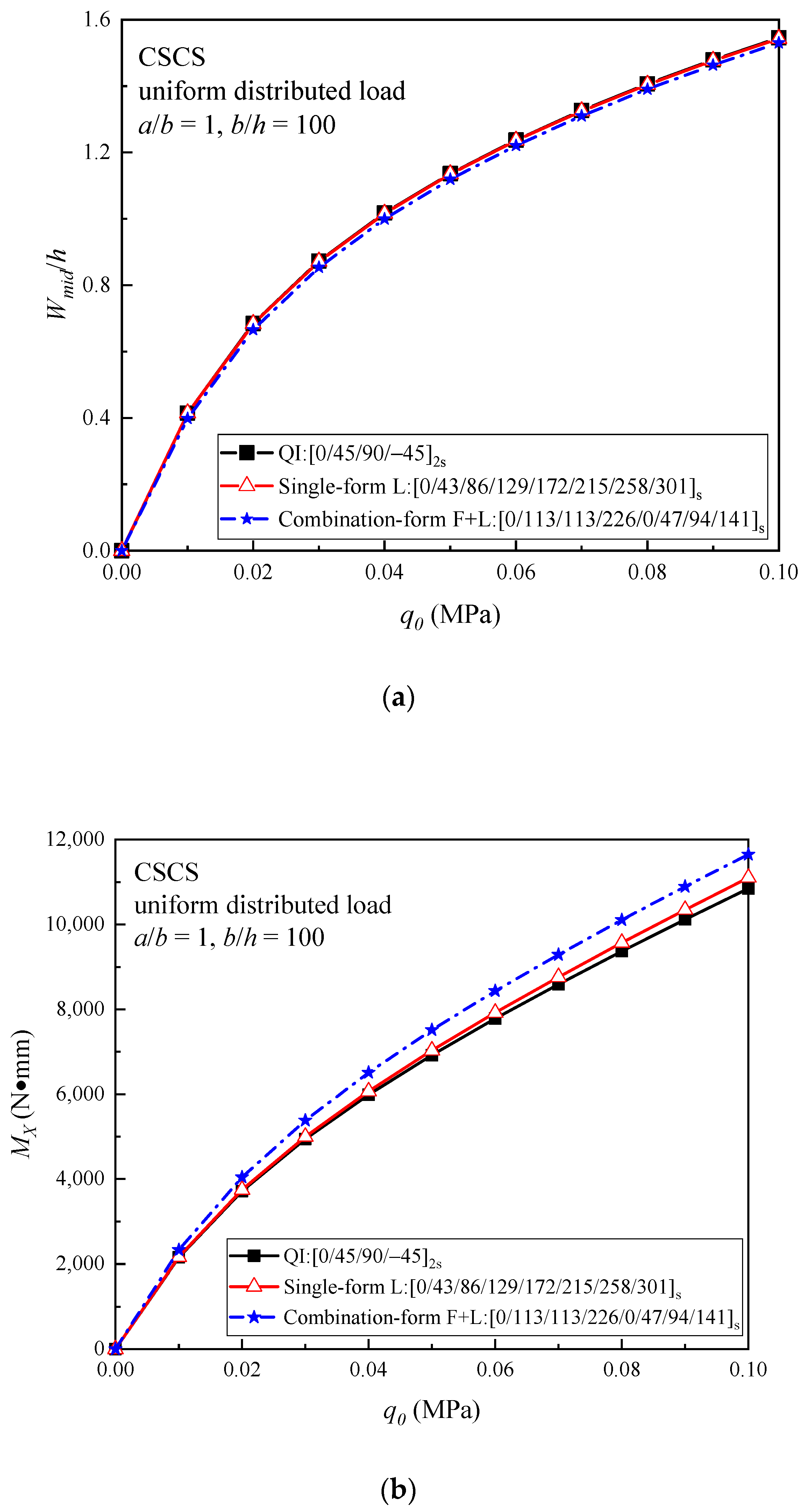In this section, the layup optimization for minimum bending deflection and the nonlinear bending analysis of helicoidal CFRPC laminated plates with optimal single-form and combination-form helicoidal layups are conducted based on the ASA optimization algorithm (on Isight) together with the FEM (in ABAQUS). Comparison works are carried out with the counterpart QI plate under CCCC, SSSS and CSCS boundary conditions subjected to a transverse uniformly distributed load. The prediction of the bending deflection in the optimization process is carried out in linear analysis. Additionally, in the subsequently nonlinear bending simulation, the geometrical nonlinearity is considered in ABAQUS/Standard with the Nlgeom option turned on.
3.1. Validation Studies
Example 1: In this case, the linear central deflection of conventional laminated plates UD ([0]
32) and QI ([0/45/90/−45]
4s) together with helicoidal laminated plates LH ([0/24/48/72/96/120/144/168/192/216/240/264/288/312/336/360]
s) and FH ([0/10/10/20/30/50/80/130/210/340/190/170/360/170/170/340]
s) under CCCC and SSSS boundary conditions subjected to transverse uniformly distributed load are calculated and compared in
Table 2. The plates have
a/
h = 100 and
a/
b = 1, and the material properties used here are:
E11/
E22 = 25,
E22 =
E33,
G12 =
G13 = 0.5
E22,
G23 = 0.2
E22,
ν12 =
ν13 =
ν23 = 0.25. In the present FE simulation, the boundary conditions are set as mentioned in
Section 2.3. As shown in
Table 3, good agreements can be observed between the dimensionless bending deflection obtained from the present FEM and those obtained by Mohamed [
14].
Example 2: In this example, a 16-ply square [0/45/−45/90]
4 laminated plate with the geometric size of
a/
b = 1 and
a/
h = 100 is considered. The CCCC, SSSS and CSCS boundary conditions are set as mentioned in
Section 2.3. The material properties [
45] are:
E11/
E22 = 25,
E22 =
E33,
G12 =
G13 = 0.5
E22,
G23 = 0.2
E22,
ν12 =
ν13 =
ν23 = 0.25. The nonlinear bending load–central deflection curves of the composite lamianted plates are presented in
Figure 5, from which a good agreement can be observed again.
3.2. Optimization of Helicoidal Layups for Minimum Bending Deflection
The layup optimization studies for better out-of-plane bending responses of helicoidal CFRPC laminated plates are carried out. The dimensionless bending deflection of symmetrical square helicoidal CFRPC laminated plates stacked with either only one (single-form) or a combination of two (combination-form) of L, R, F and E helicoidal arrangements are compared with the conventional QI, i.e., [0/45/90/−45]2s subjected to atransverse uniformly distributed load.
Table 4,
Table 5 and
Table 6 show the dimensionless bending deflection
of optimal bio-inspired helicoidal laminated plates with a layup sequence of only one of the L, R, F or E helicoidal arrangements (called single-form) under CCCC, SSSS and CSCS boundary conditions. For these single-form helicoidal plates with limited design variables of
,
,
and
, the bending deflection of all four types of helicoidal laminates subjected to a transverse uniformly distributed load are calculated and listed in
Table 4,
Table 5 and
Table 6.
The dimensionless bending deflections
for optimal single-form helicoidal laminated plates under the CCCC boundary condition in
Table 4 show that the F helicoidal laminated plate with ([0/1/1/2/3/5/8/13]
s) has the lowest bending deflection,
= 0.2933, which is 6.278% lower than that of the QI plate. The bending deflection of the optimal L, R and E helicoidal plates decreased by 6.261%, 5.743% and 4.973%, respectively, compared to the QI plate. It can be observed from the results in
Table 4 that the single-form helicoidal laminated plates with lower rotation angles tend to have higher out-of-plane bending stiffness under the CCCC boundary condition subjected to a transverse uniformly distributed load.
For the minimum dimensionless bending deflection
of CFRPC laminated plates under the SSSS boundary condition,
Table 5 gives the optimal single-form helicoidal layups. Among the four single-form helicoidal laminated plates, the L helicoidal laminated plate with ([0/51/102/153/204/255/306/357]
s) decreases the bending deflection by 0.365%. However, for the other three single-form helicoidal layups, no improvement in the out-of-plane bending stiffness can be observed, with the bending deflection of these plates being higher than that of the QI plate. It is suggested that the enhancement of the out-of-plane bending stiffness of the helicoidal CFRPC laminated plates stacked with single-form helicoidal arrangements under the SSSS boundary condition subjected to a transverse uniformly distributed load are limited.
Table 6 lists the optimal helicoidal laminated plates stacked with single-form helicoidal layups for the minimum dimensionless bending deflection
under the CSCS boundary condition. Similar to the observation for plates under the SSSS boundary condition, only the L-helicoidal laminated plate with ([0/43/86/129/172/215/258/301]
s) can decrease the bending deflection by 0.113%, and the other three single-form helicoidal plates cannot decrease the bending deflection. It is suggested that the single-form helicoidal arrangements do not contribute significantly to improving the out-of-plane bending stiffness of CFRPC laminated plates under the CSCS boundary condition subjected to a transverse uniformly distributed load.
The optimal combination-form helicoidal CFRPC laminated plates for minimum dimensionless bending deflection
under the CCCC, SSSS and CSCS boundary conditions subjected to a uniformly distributed load are listed in
Table 7,
Table 8 and
Table 9. For these CFRPC laminated plates stacked with two of the L, R, F or E helicoidal layup patterns, the ASA optimization algorithm operated on the Isight platform together with ABAQUS is applied.
The optimization results in
Table 7 show that all the combination-form helicoidal layup patterns can improve the out-of-plane bending stiffness under the CCCC boundary condition compared to the QI plate. Among them, the optimal (F + L) helicoidal plate of [0/179/179/358/0/1/2/3]
s has the lowest dimensionless bending deflection
of 0.2931, which is 6.353% lower than that of the QI plate. All the combination-form helicoidal layups can improve the out-of-plane bending stiffness of the CFRPC plate by more than 5% compared to the QI plate. Additionally, under the CCCC boundary condition, the smaller the angle between the adjacent plies, the lower the bending deflection of the laminated plate subjected to a transverse uniformly distributed load. The lower rotation angles of the helicoidal laminated plates enhance the bending stiffness
D11 obviously, which leads to the lower bending deflection.
For combination-form helicoidal CFRPC laminated plates under the SSSS boundary condition, the optimal layup patterns (L + R), (L + F), (R + L), (R + F), (R + E), (F + L) and (F + R) can decrease the dimensionless bending deflection
of laminated plates, as shown in
Table 8. The lowest
of 1.0376, 5.542% lower than the QI plate, is achieved by the (R + F) plate with ([0/50/150/300/0/45/45/90]
s). Compared to the optimal single-form helicoidal laminated plates under the SSSS boundary condition in
Table 5, the improvement in the out-of-plane bending stiffness of plates with combination-form helicoidal layups of (R + L), (R + F) and (R + E) is much more obvious. Compared to the QI ([0/45/90/−45]
2s) plate with zero
A16 and
A26, the optimal helicoidal laminated plates have the nonzero
A16 and
A26 that offers more shear stiffness than the QI plate.
The results of the layup optimization of combination-form helicoidal patterns for achieving minimum bending deflection for CFRPC laminated plates under the CSCS boundary condition subjected to a transverse uniformly distributed load are presented in
Table 9. It can be seen from the optimal helicoidal configurations that (L + R), (L + F), (R + F), (F + L), (F + R) and (F + E) can decrease the
of laminated plates compared to the QI plate. The (F + L) plate with ([0/113/113/226/0/47/94/141]
s) has the lowest
, 0.4911, which is 5.360% lower than the QI plate. Additionally, compared to the single-form helicoidal laminated plates under the CSCS boundary condition in
Table 6, the combination-form (F + L), (F + R) and (F + E) helicoidal layups can enhance the out-of-plane bending stiffness of plates much more effectively.
3.3. Nonlinear Bending Behaviors of Optimal Helicoidal CFRPC Laminated Plates
In the previous subsection, the dimensionless bending deflection of the QI and helicoidal laminated plates for linear analysis are calculated. The optimal single-form and combination-form helicoidal CFRPC laminated plates are selected to predict the nonlinear bending responses which consider the geometrical nonlinearity. For the laminated plates under the CCCC boundary condition, the nonlinear bending responses of the optimal single-form F-helicoidal plate of [0/1/1/2/3/5/8/13]s and combination-form (F + L) helicoidal plate of [0/179/179/358/0/1/2/3]s are compared with that of the QI plate. For the laminated plates under the SSSS boundary condition, the optimal single-form L-helicoidal plate of [0/51/102/153/204/255/306/357]s and combination-form (R + F) plate of [0/50/150/300/0/45/45/90]s are selected. Additionally, for the laminated plates under the CSCS boundary condition, the optimal single-form L-helicoidal plate of [0/43/86/129/172/215/258/301]s and combination-form (F + L) plate of [0/113/113/226/0/47/94/141]s are selected. All the plates have the same geometric size, with a = 224 mm, b = 224 mm and h = 2.24 mm, and are subjected to a transverse uniformly distributed load. In the following figures, and represent the deflection of the center point on the middle plane and the central bending moment of the plate, respectively.
Figure 6 illustrates the nonlinear bending response of the optimal helicoidal plates and QI plate under the CCCC boundary condition. It can be observed that the F and (F + L) helicoidal plates have very close curves which are lower than QI plate for both the load–central deflection and the load–bending moment curves. During the nonlinear bending process, the optimal F and (F + L) helicoidal plates maintain the higher out-of-plane bending stiffness under the CCCC boundary condition subjected to a uniformly distributed load.
In
Figure 7, the relationships between the applied load and the central deflection together with the applied load and the bending moment are presented. The results show that the load–central deflection curves of these three plates are close under the SSSS boundary condition, while the enhancement of the out-of-plane bending properties is not obvious for the optimal helicoidal laminated plates compared with the QI plate during the nonlinear bending process. On the other hand, the load–bending moment curves of the optimal plates are lower than those of the QI plate.
The nonlinear bending responses of the optimal helicoidal laminated plates under the CSCS boundary condition are given in
Figure 8. It can be seen from the results that, among the three plates, the (F + L) plate has the lowest load–central deflection curve, but the highest load–bending moment curve. The load–central deflection curves of the optimal L helicoidal plate and QI plate are very close, while the load–bending moment curve of the L plate is slightly higher than that of the QI plate.














